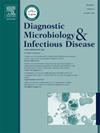改良的阳性时间是社区起病单微生物血液感染成人短期死亡率的关键决定因素
IF 2.1
4区 医学
Q3 INFECTIOUS DISEASES
Diagnostic microbiology and infectious disease
Pub Date : 2025-02-11
DOI:10.1016/j.diagmicrobio.2025.116738
引用次数: 0
摘要
时间到阳性(TTP)在预测个体经历血流感染(bsi)的预后方面的潜在表现尚未达成共识。该回顾性队列研究纳入了1015例未接受治疗的社区起病单微生物性脑梗死成人,旨在评估TTP和改良TTP (mTTP, TTP加上运输时间)在预测预后混杂因素(特别是适当抗生素使用时间(TtAa))后30天死亡率方面的表现。通过Spearman相关,发现mTTP与30天死亡率之间存在显著的线性相关(ρ = -0.943, P = 0.005),但TTP与总体患者群体的30天死亡率之间没有显著的相关性(ρ = -0.423, P = 0.26)。在logistic回归模型中,mTTP或TTP每增加1小时与平均下降5%相关(调整优势比[AOR], 0.95;P = 0.001)或3% (AOR, 0.97;P = 0.03),在调整了30天死亡率的独立预测因子后。总之,对于社区发病的单菌性脑梗死成人,mTTP在预测短期死亡率方面比单独使用TTP更有优势。本文章由计算机程序翻译,如有差异,请以英文原文为准。
Modified time-to-positivity as a crucial determinant of short-term mortality among adults with community-onset monomicrobial bloodstream infections
The potential performance of time-to-positivity (TTP) in predicting the prognosis of individuals experiencing Bloodstream infections (BSIs) has achieved little consensus. The retrospective cohort of 1015 treatment-naive adults with community-onset monomicrobial BSIs aimed to assess the performance of TTP and modified TTP (mTTP, TTP plus transportation time) in predicting 30-day mortality after adjusting for prognostic confounders, particularly the time-to-appropriate antibiotic (TtAa). Through Spearman's correlation, a significant linear-by-linear association (ρ = -0.943, P = 0.005) was exhibited between mTTP and 30-day mortality rates, but no significant association (ρ = -0.423, P = 0.26) was disclosed between TTP and 30-day mortality rates in the overall patient population. In the logistic regression model, each additional hour of mTTP or TTP was associated with an average decrease of 5 % (adjusted odds ratio [AOR], 0.95; P = 0.001) or 3 % (AOR, 0.97; P = 0.03) in the 30-day mortality rates, respectively, after adjusting for independent predictors of 30-day mortality. In conclusion, for adults with community-onset monomicrobial BSIs, mTTP revealed a favorable performance over TTP alone in predicting short-term mortality.
求助全文
通过发布文献求助,成功后即可免费获取论文全文。
去求助
来源期刊
CiteScore
5.30
自引率
3.40%
发文量
149
审稿时长
56 days
期刊介绍:
Diagnostic Microbiology and Infectious Disease keeps you informed of the latest developments in clinical microbiology and the diagnosis and treatment of infectious diseases. Packed with rigorously peer-reviewed articles and studies in bacteriology, immunology, immunoserology, infectious diseases, mycology, parasitology, and virology, the journal examines new procedures, unusual cases, controversial issues, and important new literature. Diagnostic Microbiology and Infectious Disease distinguished independent editorial board, consisting of experts from many medical specialties, ensures you extensive and authoritative coverage.

 求助内容:
求助内容: 应助结果提醒方式:
应助结果提醒方式:


